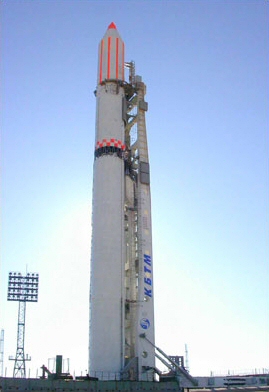
Zenit was a family of space launch vehicles designed by the Yuzhnoye Design Bureau in Dnipro, Ukraine, which was then part of the Soviet Union. Zenit was originally built in the 1980s for two purposes: as a liquid rocket booster for the Energia rocket and, equipped with a second stage, as a stand-alone middle-weight launcher with a payload greater than the 7 tonnes of the Soyuz but smaller than the 20 tonnes payload of the Proton. The last rocket family developed in the USSR, the Zenit was intended as an eventual replacement for the dated Soyuz and Proton families, and it would employ propellants which were safer and less toxic than the Proton's nitrogen tetroxide/UDMH mix. Zenit was planned to take over crewed spaceship launches from Soyuz, but these plans were abandoned after the dissolution of the Soviet Union in 1991.

The Dnepr rocket was a space launch vehicle named after the Dnieper River. It was a converted ICBM used for launching artificial satellites into orbit, operated by launch service provider ISC Kosmotras. The first launch, on April 21, 1999, successfully placed UoSAT-12, a 350 kg demonstration mini-satellite, into a 650 km circular Low Earth orbit.

The State Space Agency of Ukraine is the Ukrainian government agency responsible for space policy and programs. Along with the Ukrainian Defense Industry and the Antonov Aeronautical Scientific-Technical Complex, it is a major state complex of the national defense industry of Ukraine.The agency was formed in 1992 based on the Soviet space program infrastructure remaining in Ukraine following the dissolution of the Soviet Union.
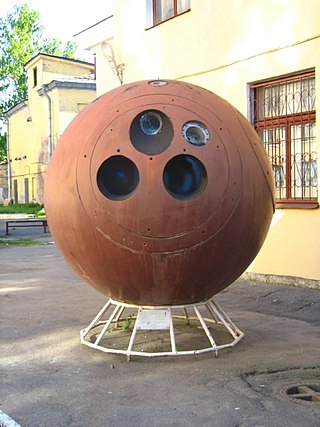
Zenit was a series of military photoreconnaissance satellites launched by the Soviet Union between 1961 and 1994. To conceal their nature, all flights were given the public Kosmos designation.

The Soyuz-U launch vehicle was an improved version of the original Soyuz rocket. Soyuz-U was part of the R-7 family of rockets based on the R-7 Semyorka missile. Members of this rocket family were designed by the TsSKB design bureau and constructed at the Progress factory in Samara, Russia. The first Soyuz-U flight took place on 18 May 1973, carrying as its payload Kosmos 559, a Zenit military surveillance satellite. The final flight of a Soyuz-U rocket took place on 22 February 2017, carrying Progress MS-05 to the International Space Station.
The Zenit-2M, Zenit-2SB, Zenit-2SLB or Zenit-2FG was a Ukrainian expendable carrier rocket derived from the Zenit-3SL. It was a member of the Zenit family of rockets, which were designed by the Yuzhmash.
The RD-8 is a Soviet / Ukrainian liquid propellant rocket engine burning LOX and RG-1 in an oxidizer rich staged combustion cycle. It has a four combustion chambers that provide thrust vector control by gimbaling each of the nozzles in a single axis ±33°. It was designed in Dnipropetrovsk by the Yuzhnoye Design Bureau as the vernier thruster of the Zenit second stage. As such, it has always been paired with the RD-120 engine for main propulsion.
Fregat (Russian: Фрегат, frigate) is an upper stage developed by NPO Lavochkin in the 1990s, which is used in some Soyuz and Zenit launch vehicles, but is universal and can be used as a part of a medium and heavy class launch vehicles. Fregat became operational in February 2000. Its liquid propellant engine uses UDMH and N2O4. Fregat's success rate is 97.3%, (with 2 failures and 1 partial failure), which makes it one of the most reliable upper stages in the world. Fregat has successfully delivered more than 300 payloads into different orbits. It remains the only upper stage in the world that can place its payload into 3 or more different orbits in a single launch.

Soyuz-2 is a modernised version of the Soviet Soyuz rocket. In its basic form, it is a three-stage launch vehicle for placing payloads into low Earth orbit. Compared to the previous versions of the Soyuz, the first-stage boosters and two core stages feature uprated engines with improved injection systems. Digital flight control and telemetry systems allow the rocket to be launched from a fixed launch platform, whereas the launch platforms for earlier Soyuz rockets had to be rotated as the rocket could not perform a roll to change its heading in flight.

The Soyuz-FG launch vehicle was an improved version of the Soyuz-U from the R-7 family of rockets, designed and constructed by TsSKB-Progress in Samara, Russia. Guidance, navigation, and control system was developed and manufactured by "Polisvit" Special Design Bureau.

Spektr-R was a Russian scientific satellite with a 10 m (33 ft) radio telescope on board. It was launched on 18 July 2011 on a Zenit-3F launcher from Baikonur Cosmodrome, and was designed to perform research on the structure and dynamics of radio sources within and beyond the Milky Way. Together with some of the largest ground-based radio telescopes, the Spektr-R formed interferometric baselines extending up to 350,000 km (220,000 mi).

GLONASS-K is the latest satellite design intended as a part of the Russian GLONASS radio-based satellite navigation system. Developed by ISS Reshetnev and first launched on 26 February 2011, it is a substantial improvement of the previous GLONASS-M second-generation satellites, having a longer lifespan and better accuracy.
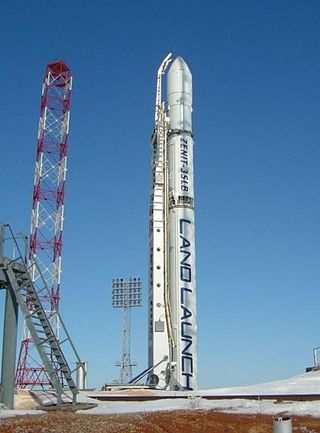
The Zenit 3SLB or Zenit-3M was a Ukrainian expendable carrier rocket derived from the Zenit-2SB. It was a member of the Zenit family of rockets, which were designed by the Yuzhnoye Design Office. Produced at Yuzhmash, the rocket was a modified version of the Zenit-3SL, designed to be launched from a conventional launch pad rather than the Sea Launch Ocean Odyssey platform. Most of components of the rocket were produced in Russia. The Ukrainian space industry was highly integrated with that of Russia due to its Soviet heritage, but that cooperation was interrupted by the Russo-Ukrainian War beginning in 2014, which effectively led to a hiatus in the Zenit program. The subsequent Russian invasion of Ukraine in 2022 saw damage to its manufacturing facilities due to Russian missile strikes, and what survived those strikes pivoted to producing military weapons.
Kosmos 453, known before launch as DS-P1-Yu No.44, was a Soviet satellite which was launched in 1971 as part of the Dnepropetrovsk Sputnik programme. It was a 325-kilogram (717 lb) spacecraft, which was built by the Yuzhnoye Design Bureau, and was used as a radar calibration target for anti-ballistic missile tests.
The RD-120 is a liquid upper stage rocket engine burning RG-1 and LOX in an oxidizer rich staged combustion cycle with an O/F ratio of 2.6. It is used in the second stage of the Zenit family of launch vehicles. It has a single, fixed combustion chamber and thus on the Zenit it is paired with the RD-8 vernier engine. The engine was developed from 1976 to 1985 by NPO Energomash with V.P. Radovsky leading the development. It is manufactured by, among others, Yuzhmash in Ukraine.

Elektro–L is a series of meteorological satellites developed for the Russian Federal Space Agency by NPO Lavochkin. The first satellite, Elektro-L No.1, was launched on 2 January 2011. It is the first Russian weather satellite that successfully operates in geostationary orbit, and is currently the second operational Russian weather satellite. The satellites have a mass of about 1620 kg and are designed to operate for 10 years each. They are capable of producing images of the Earth's whole hemisphere in both visible and infrared frequencies, providing data for climate change and ocean monitoring in addition to their primary weather forecasting role.

Elektro-L No.1, also known as Geostationary Operational Meteorological Satellite No.2 or GOMS No.2, is a Russian geostationary weather satellite which was launched in 2011. The first Elektro-L spacecraft to fly, it became the first Russian geostationary weather satellite to be launched since Elektro No.1 in 1994.
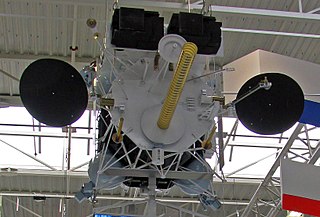
Elektro-L No.2 is a Russian geostationary weather satellite which launched on 11 December 2015. It is the second Elektro-L spacecraft to fly, after Elektro-L No.1 launched in 2011. The Elektro-L No. 2 satellite system was developed by Lavockhin and is part of the second generation of Russian geosynchronous weather satellites. The space platform has an upgrade in star trackers and radio complex. The MSU-GS camera also passed additional tests to improve performance in infrared channels.
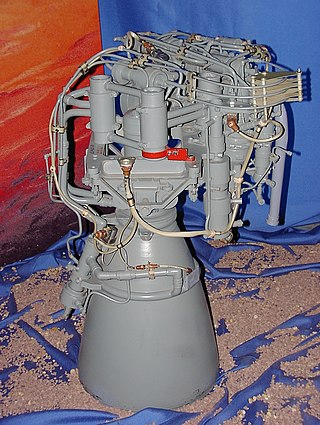
The S5.92 is a Russian rocket engine, currently used on the Fregat upper stage.
The RD-801 is a Ukrainian liquid propellant rocket engine burning LOX and Kerosene (RG-1) in a staged combustion cycle. It has a single combustion chamber that provides thrust vector control by gimbaling of the nozzle in two axis by +/- 6°. It is being designed in Ukraine by Yuzhnoye Design Bureau for the prospective first stage propulsion of the Mayak rocket family.














